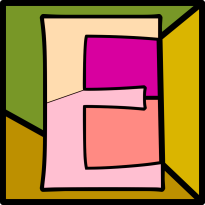G'MIC Cheatsheets
 | Welcome to the G'MIC command line interface (cli) cheatsheet directory. Cheats consist of pithy recipes for common tasks and/or ways to avoid typical gaffes. G'MIC is a command line interface tool. Use your operating system's CLI to: 1. put images on an image list, 2. apply an image processing pipeline to image list items, 3. output results in a well-understood manner. If you have not used the G'MIC cli at all! (as in: never!), then visit Tutorial Introduction and Basics. Can’t cheat unless you know what you’re cheating at. |
In G'MIC, pipelines — ordered command sequences — operate on image lists. A gmic pipeline typically has these parts:
| gmic | <input list items> | <commands> | <output adaptors> | output[ <selection> ] <filename template> |
| Start the interpreter | Populate the image list with -input variants | operate on selections of image list items | Use -cut or -normalize and friends to adapt list items in a well understood manner. | -output a selection of adapted list items to storage. |
Apart from starting the interpreter, the remaining pipeline parts may be broken up and interleaved. There may be other less vital parts as well. Example: display intermediary list items. When pipeline proof-reading, be comfortable identifying which part does what. No? Then go to the more prolix tutorials.
Before Cheating
Skip to Cheats if you know what you are doing.Check List
| 1. | Installed the G'MIC Command Line Interface ( Tell me how )? | □ |
| 2. | Know the difference between the cli and gmic-qt ? | □ |
| 3. | Know how to access and use your operating system shell? | □ |
| 4. | Understand what output in a well understood manner means? | □ |
Bail out
If you miss a check then you are on the wrong page. Bail. Out. Now.| 1. | There is no help here on using G’MIC in a paint program (gmic-qt). Try discuss.pixls.us or Gimp Chat. |
| 2. | Help for outputting images in a well understood manner may be found at Images and Images as Data Sets. |
Good to Go
With G’MIC cli you:| 1. | Put images on the image list |
| 2. | Apply a set of image processing commands |
| 3. | Output results in a well-understood manner |
Put these three injunctions on a yellow sticky pad. Paste it within eyesight. Until it becomes muscle memory, be able to identify:
| 1. | Where and how you populate the image list, |
| 2. | Apply image processing commands, |
| 3. | Output results in a well-understood manner. |
for any cli command you write. Basic Pipeline Anatomy: Populate. Apply. Output.
The well-understood manner injunction delineates G’MIC cli from paint programs. The cli provides vast image processing freedoms. Even the freedom to be silly. To provide freedom efficiently — including freedom from nagging software! ("Are You Sure You Want To Do That? OK") the cli removes all guard rails. Sans guard rails, one may output signed floating point data to Portable Network Graphics (.png) containers. The cli trusts you have your reasons. Corollary: Know what output you want and how you are going to use it.
Cheats
Start here.| Cheat Home | Custom Cheat | Display Cheat | Debug Cheat | Array Cheat | Substitution Cheat |


 Home
Home Download
Download News
News Mastodon
Mastodon Bluesky
Bluesky X
X Summary - 17 Years
Summary - 17 Years Summary - 16 Years
Summary - 16 Years Summary - 15 Years
Summary - 15 Years Summary - 13 Years
Summary - 13 Years Summary - 11 Years
Summary - 11 Years Summary - 10 Years
Summary - 10 Years Resources
Resources Technical Reference
Technical Reference Scripting Tutorial
Scripting Tutorial Video Tutorials
Video Tutorials Wiki Pages
Wiki Pages Image Gallery
Image Gallery Color Presets
Color Presets Using libgmic
Using libgmic G'MIC Online
G'MIC Online Community
Community Discussion Forum (Pixls.us)
Discussion Forum (Pixls.us) GimpChat
GimpChat IRC
IRC Report Issue
Report Issue